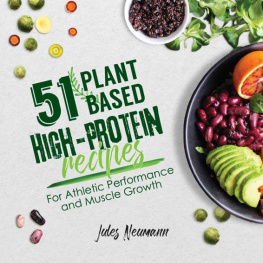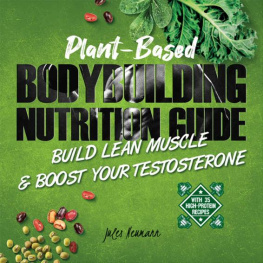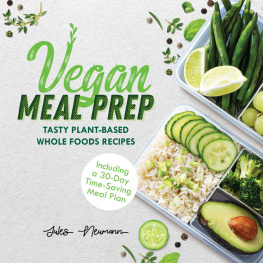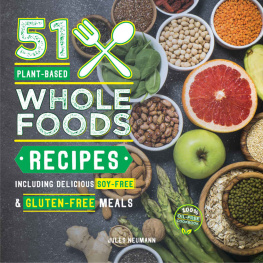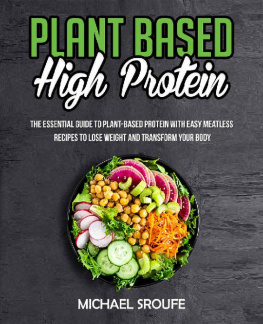Congratulations on your responsible and health-conscious decision to read this book.
Were grateful youve joined us and excited for your journey ahead.
We offer our readers the exclusive opportunity to become part of our readers circle. Dozens of people are already enjoying bonus plant-based recipes and extra support on their journey to better cooking, meal-prepping, and weight loss (or gain, when intended).
Become part of our readers circle today and get The Vegan Cookbook free of charge!
Simply subscribe to our newsletter and join hundreds of people with similar ethics and goals.
By becoming part of our readers circle, you will receive our latest recipes, useful articles, and many more tips to stay healthy, right in your inbox.
Our readers enjoy unique support in their health plans and can always reach out to us for personal questions.
Subscribe , become part of our readers circle and g et instant access to our unique The Vegan Cookbook !
Enter your email address and let us help you stay committed.
Choose the plant-based lifestyle and renounce animal cruelty. See you inside the readers circle!
**We hate spam and will never email you more than twice a week.
Soaking Methods and Cooking Staple Foods
Some plant-based whole foods come up time and again in various recipes and are good to have available in the pantry throughout the year. These ingredients are ideal as a base; they add texture, flavor, fiber, complex carbs, and protein to your meals. Amongst these staples are beans, grains, nuts, and seeds. These all contain phytic acid, a natural substance found in plant seeds that protects the seeds from insects or from sprouting too early. When people consume phytic acid, however, it impairs the absorption of important micronutrients like calcium, magnesium, copper, zinc, and iron.
In order to reduce the phytic acid in these foods, use soaking, sprouting, and/or cooking as a method to improve their nutritional value. Some foods are particularly high in phytates and are often consumed in large amounts on a plant-based whole-foods diet. Examples include almonds, sesame seeds, peanuts, soy beans, kidney beans, navy beans, and other types of legumes. Therefore, reducing the phytic acids in ingredients with a large number of phytic acids is vital to avoid serious malnutrition and disrupted gut health.
There are various ways to solve this problem. In general, beans and lentils are best soaked, sprouted, and/or cooked to get rid of phytic acids. Nuts need to be roasted, sprouted, or soaked. Buckwheat needs to be soaked and cooked. Grains like spelt or oats are best cooked for a longer period to get rid of the phytic acids. Sometimes fermenting is a preferred alternative to alter texture and get rid of most of the phytic acids. Soy products and chickpea tempeh are good examples of fermented products like this, but this book will not go into the details of that process.
Soaking
Soaking (dry) staples that are rich in phytic acids is absolutely necessary to guarantee proper nutrient absorption and a healthy gut. Most recipes in this book use raw beans, lentils, and nuts, which are very affordable to buy, effective to store and all easy to soak to effectively reduce their natural content of phytic acids. A popular and effective alternative to soaking is sprouting. Both methods are explained below.
1. Overnight soak
Leaving beans, lentils, and legumes in a pot filled with water overnight, meaning at least 8 hours, is the most effective way to soak. Use roughly 10 cups of water for every pound of dry beans or legumes (roughly 2 cups) and discard the excess water after the overnight soak. Recommended soaking times for different kinds are displayed in the chart below.
2. Hot soak
A quicker soaking method is to fill up a pot that is large enough to fit both the beans, lentils, or legumes and water. Use roughly 10 cups water for each pound (roughly 2 cups) of dry beans or legumes. Heat up the pot and bring the water to a boil. Once the water reaches a boiling point, immediately turn down the heat and allow the water to softly simmer for a few minutes. Continue to cover the pot, remove it from the heat, and allow the beans to sit for 1 to 4 hours. Discard the excess water after the hot soak.
Rinsing
After using the overnight or hot-soaking method, get rid of all the excess water that is left in the pot and rinse the beans or legumes once or twice with fresh, cool water. This will wash off any remaining indigestible sugars and phytic acids. After doing so, the soaked and rinsed beans or legumes are ready to be cooked.
Boiling
To boil beans and legumes, fill a pot that is large enough to accommodate the soaked beans or legumes with water. Make sure to cover the beans or legumes with an excess amount of water, which should be at least 1 inch. Partially cover the pot with a lid and put the pot over medium heat until the water is boiling. Aim for a soft boil and reduce the heat if necessary.
Note that both dry and canned Cannellini, white kidney, and red beans require to be boiled for at least a few minutes to get rid of the naturally present poison in these beans.

